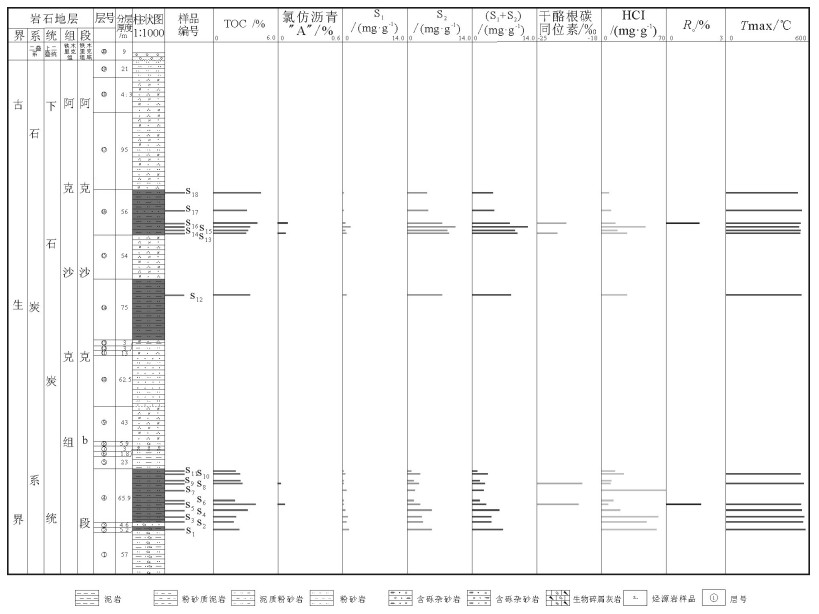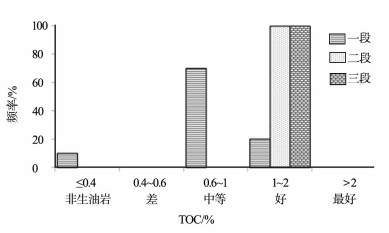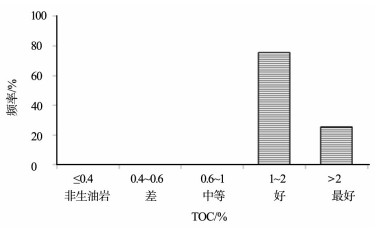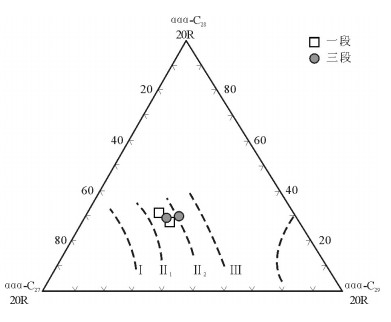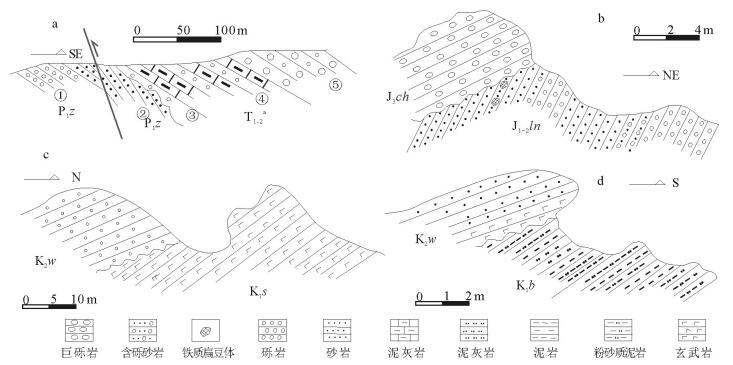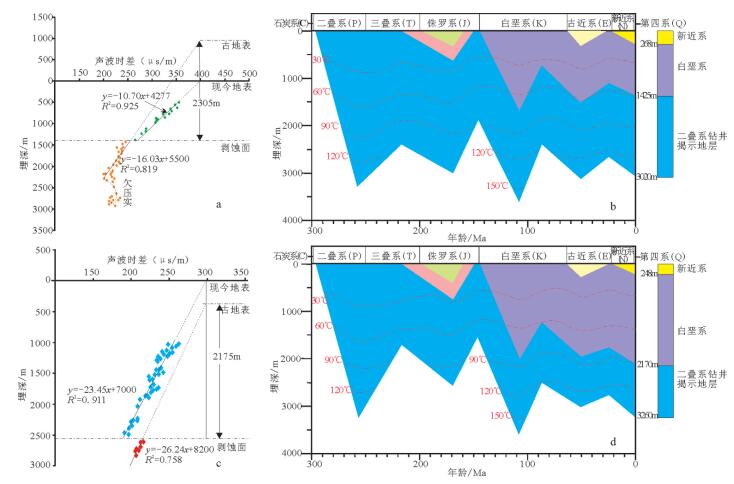A preliminary study of the structure and reformation of the Permian and Carboniferous strata in Yingen-Ejin basin and its periphery
-
摘要:
通过银额盆地周缘野外地质调查,结合岩石薄片显微构造、磷灰石裂变径迹研究,以及盆地内部综合物化探与地震剖面、钻井等资料,对银额盆地及周缘晚古生代与中新生代地层构造变形及改造进行了分析,并对石炭系与二叠系后期构造改造期次及动力学机制进行了初步探讨。就石炭系和二叠系构造变形而言,露头区构造变形强于盆地内部,北山地区变形程度强于洪格尔山地区。石炭系与二叠系主要遭受了华力西末期、早中燕山期、燕山晚期、喜马拉雅期构造改造作用。第一期变形强烈,以差异隆升为主;第二期区域上变形最强烈,主要表现为区域抬升及大规模的逆冲推覆构造;第三、四期主要为轻微的差异升降作用,分别受控于太平洋板块向华北地块俯冲和印度板块向欧亚大陆俯冲的远程效应。石炭系与二叠系多套烃源岩于早白垩世末期达到最大埋深,进入主要生烃期,早白垩世以来受后期构造改造较弱,形成的大面积河湖相沉积可作为有效的储层与盖层,为银额盆地油气成藏提供了良好的生储盖条件。
Abstract:In this study, structure deformation features of the Carboniferous, Permian and Meso-Cenozoic strata were analyzed in Yingen-Ejin basin and its periphery, and geological survey was conducted mainly based on geophysical prospecting and drilling in the interior of the basin. The deformation of the Carboniferous and Permian outcrops is stronger than that in the interior of the basin, and stronger in Beishan than in Honggeershan. The tectonic deformation stages and dynamic mechanism after Permian were preliminarily discussed. Four tectonic stages, i.e., Late Variscan, Early Yanshanian, Late Yanshanian and Himalayan tectonic movement, were distinguished. The deformation was strong in the first period. The second phase deformation is the strongest in the region in that large-scale nappe structure and regional uplift were formed during this period; the overall tectonic pattern was formed in the Late Jurassic. The third and fourth stages were mainly characterized by differential uplifting and subsidence, with the dynamic mechanism being separately controlled by the remote effects of the subductions of the Pacific plate under the North China block and the subduction of the India plate under the Eurasia. The source rock of Carboniferous-Permian was buried most deeply with the formation of oil until the end of Early Cretaceous. Furthermore, the structural activities were insignificant after the Early Cretaceous, which was favorable for the formation of hydrocarbon reservoir.
-
Keywords:
- Yingen-Ejin basin /
- Carboniferous /
- Permian /
- structure and reformation
-
长期以来,伊宁盆地的油气勘探工作主要针对中生界及上二叠统[1-3],未取得明显进展。近年准噶尔盆地和三塘湖盆地石炭系油气勘探取得重大突破,是天然气产量的主要增长区,使中国北方石炭系成为重要的油气资源新层系。伊宁盆地与准噶尔盆地、三塘湖盆地在石炭纪具有相同的构造背景,因此需要对伊宁盆地石炭系烃源岩进行评价,明确其是否具有较好的生烃条件。
李玉文等[1]、郝继鹏等[4]对下石炭统阿克沙克组烃源岩进行了初步评价。本文通过对阿克沙克剖面和琼阿希剖面阿克沙克组烃源岩分布及油气地球化学特征的系统分析,明确了该套烃源岩具有良好的生烃条件,指示伊宁盆地石炭系具有良好的油气资源前景。
1. 地质背景
伊宁盆地位于新疆维吾尔自治区西部,盆地西部与哈萨克斯坦及吉尔吉斯坦接壤,东部收敛于南、北天山接合部,呈西宽东窄、向西开口的三角形,石炭系地层在区内广泛分布(图 1)。
伊宁盆地属于古生代和中生代叠合盆地,对西天山伊犁地区石炭纪火山-沉积岩系形成构造环境的认识目前还存在很大争议,其中一种主要观点认为,古天山洋的闭合时间在晚泥盆世之前,早石炭世开始进入新的造山后裂谷拉伸阶段,火山-沉积岩系具有板内裂谷火山岩系岩石地球化学特征,形成于碰撞后裂谷拉伸环境[5-6]。这些火山-沉积岩系的形成可能与碰撞后裂谷拉张环境的古地幔柱活动有关[7]。西天山伊犁地区石炭纪火山-沉积盆地充填序列反映了裂谷盆地充填演化过程[8]。笔者所在的研究团队通过野外调查,利用火山岩地球化学和沉积建造综合分析,结合前人资料,认为伊宁盆地石炭纪为大陆裂谷环境,与前人认识一致。
伊宁盆地石炭系自下而上可划分为4套岩石组合:大哈拉军山组(C1d)→阿克沙克组(C1a)→伊什基里克组(C2y)→东图津河组(C2d)。大哈拉军山组岩石组合为玄武岩、安山岩、流纹岩、粗面岩、火山碎屑岩、碎屑岩及少量灰岩;阿克沙克组岩石组合为含砾粗砂岩、砂岩、生物碎屑灰岩和泥岩;伊什基里克组岩石组合为玄武岩、流纹岩及火山碎屑岩;东图津河组岩石组合为砂岩、细砂岩夹砂砾岩及泥灰岩。阿克沙克组沉积时期,海水范围最大,各地层之间为火山喷发不整合或整合接触关系,总体反映了石炭纪盆地火山喷发-正常沉积的充填过程和海侵到海退的沉积环境变化。
2. 烃源岩展布特征
2.1 阿克沙克组岩石组合特征
研究剖面主要为阿克沙克剖面,该剖面是下石炭统阿克沙克组的建组剖面,位于昭苏县城西北方向的阿克沙克沟地区。阿克沙克组与下伏下石炭统大哈拉军山组整合接触,与上覆二叠系铁木里克组呈角度不整合接触,自下而上可划分为a、b两段,a段下部以灰色中厚层长石杂砂岩、细砂岩为主,上部粒度变细,以粉砂岩和泥质粉砂岩为主,含植物碎片化石;b段下部以灰色中层状泥晶生屑灰岩、介壳灰岩、生屑灰岩为主,偶夹少量薄层砂岩,上部以粉砂质泥岩和泥岩为主。伊宁市东北的琼阿希剖面,地层出露不全,未见顶底,发育一套暗色泥岩。
2.2 烃源岩纵向分布
阿克沙克剖面实测结果表明,暗色泥岩集中分布在b段中上部,主要集中分布在三段(图 2),厚度较大,自下而上,厚度依次为65.9m(一段)、75m(二段)、56m(三段),在一段下部有一套5.2m厚的薄层暗色泥岩,累计厚度可达202.1m;琼阿希剖面可见一套28m厚的暗色泥岩。
3. 烃源岩地球化学特征
烃源岩的有效评价直接决定了油气勘探的方向与前景。对于中国古生界海相烃源岩的评价标准目前争论仍较大[9-10],参考前人研究成果,并结合伊宁盆地实际特点,本次研究采用SY/T5735—1995国家标准对阿克沙克组烃源岩进行评价。
3.1 有机质丰度
有机质丰度评价通常采用总有机碳含量(TOC)、生烃潜量(S1+S2)、氯仿沥青“A”等指标。对于地表剖面采集的样品或演化程度较高的样品,生烃潜量(S1+S2)和氯仿沥青“A”作为丰度指标评价烃源岩受影响较大,与钻井岩心样品的测试结果相比,这2个参数的值往往低许多,难以反映真实的有机质丰度特征,仅可作为参考指标[11-13]。
3.1.1 总有机碳(TOC)含量
阿克沙克剖面采集18个样品进行了总有机碳含量及热解分析。结果表明,TOC含量主体分布在0.6%~2%之间,平均为1.19%,达到中等-好标准(图 3),TOC大于1%的泥岩累计厚度达144.18m。纵向上自下而上TOC含量逐渐增大,平均值分别为0.79%、1.17%、1.19%,二段、三段全部样品TOC均大于1%,达到好标准。在琼阿希剖面采集了8个烃源岩样品进行分析,TOC均大于1%,部分样品TOC大于2%,平均值为1.73%,达到好-最好标准(图 4)。
3.1.2 生烃潜量和氯仿沥青“A”
阿克沙克剖面烃源岩生烃潜量(S1+S2)仅为0.04~0.43mg/g,平均值为0.19mg/g,氯仿沥青“A”仅为0.005%~0.015%,平均值为0.011%,指示非-差标准。琼阿希剖面烃源岩S1+S2较高,为0.55~1.80mg/g,平均值为1.13mg/g,为差标准;氯仿沥青“A”主体为0.020%~0.057%,平均值为0.034,显示差-中等标准,低于TOC评价结果(图 5)。
综上所述,由于地表样品风化影响严重,研究区露头样品的S1+S2及氯仿沥青“A”均低于TOC判别结果,不适宜作为烃源岩丰度的评价指标。TOC结果显示,阿克沙克组暗色泥岩有机质丰度可达中等-好标准。
3.2 有机质类型
有机质类型的评价指标较多,但对于地表露头样品或高-过成熟样品,部分指标不宜采用,如风化作用往往引起C、H元素流失,O元素相对富集,使有机质类型向Ⅲ型偏移,导致与之相关的IH-IO和H/CO/C判别方法可信度降低;风化作用同样会引起S2降低,使对应的Tmax峰值不准确,导致IH-Tmax(最高热解峰温)判别方法可信度降低;此外,随着热演化程度增加,干酪根碳同位素(δ 13CPDB)逐渐变重,H/C-O/C向碳极收敛,正构烷烃碳优势逐渐消失[13-18]①,相关参数的使用均须慎重。相比之下,甾烷等生物标志化合物稳定,能够有效地保留原始有机质来源信息,与之相关的类型参数为目前能够有效划分露头或高成熟样品有机质类型的重要指标。
3.2.1 正构烷烃
不同来源的正构烷烃,其组成特征差异较大。一般认为,具有奇偶优势的高碳数(>C23)正构烷烃的分布指示陆源有机质的输入,以C15、C17为主,奇偶优势不明显的中等相对分子质量(nC15~nC21)的正构烷烃指示藻类等低等水生生物来源[11]。
根据阿克沙克剖面一、三段烃源岩代表样品的饱和烃色谱图(图 6),受到生物降解作用影响,色谱基线均有一定的漂移,且高碳数缺失较多,由于CPI考察C24~C34段的奇偶性,所以该参数会有一定程度的失真,如阿克沙克剖面样品的CPI高值可达2.10,低值为1.22。而OEP仅考察主峰碳及前后4个碳数的正构烷烃,因此影响较小,如同一剖面对应样品的OEP仅为0.83~1.02,结合Ro结果表明,基本为成熟偏高导致的奇偶优势比消失,但从正构烷烃的峰型特征看,整体均呈双峰态分布,且前锋较高,表明有机质来源为低等水生生物及高等植物混合贡献,且前者贡献较高。此外,Ph/nC18-Pr/nC17特征也指示Ⅰ型有机质贡献较高(图 7)。
3.2.2 甾烷化合物
尽管许多缺乏陆生植物的前泥盆纪沉积物中富含C29甾烷,但一般仍认为,水生生物富含C27和C28甾烷,而高等植物富含C29甾烷,故可通过有机质的甾烷谱图特征及C27-C28-C29相对含量百分图来判断干酪根的有机质类型。
根据阿克沙克剖面一段、三段烃源岩代表样品的饱和烃色质图,C27αααR、C28αααR、C29αααR甾烷系列的相对组成分布大多具有混源特征,以C27占优势,显示Ⅱ1型有机质特征。从样品的ααα 20R构型C27-C28-C29甾烷三角图同样可以看出(图 8),该剖面阿克沙克组烃源岩有机质类型以Ⅱ1为主。
3.2.3 其他参数
由于风化作用及高成熟度影响,部分常用判别参数所得出的研究剖面目的层烃源岩有机质类型差别较大,如7个δ13CPDB分布范围为-23.8‰ ~ -20.1‰,均指示Ⅲ型特征,δ13CPDB偏重可能与热演化程度较高有关;8个样品饱/芳值分布在0.4~1.6之间,其中阿克沙克剖面中1个样品(S8)的饱/芳值为1.6,指示Ⅱ1型,另外3个样品(S5,S13,S16)的饱/芳值均小于1.0,指示Ⅲ型。琼阿希剖面的4个样品均小于1.0,指示Ⅲ型,饱和烃含量偏低可能与其主要组成—正构烷烃对生物降解和热力作用最敏感有关;H/C-O/C结果指示有机质为Ⅱ2~Ⅲ型,其中阿克沙克剖面的4个样品均指示Ⅲ型,琼阿希剖面的1个样品(S3)为Ⅱ2型,其余3个样品(S1,S6,S8)均为Ⅲ型,H、O元素的差异亏损可能与差异风化有关。上述3种参数判别效果较差,本次主要利用生物标志化合物进行判别。
综合分析,生物标志化合物受风化、热演化作用等影响较小,可作为有机质类型判别的主要依据。根据阿克沙克组烃源岩甾烷组合特征分析,有机质类型主要为Ⅱ1型,部分样品为Ⅱ2型,与浅海陆棚沉积环境一致。
3.3 有机质成熟度
镜质体反射率(Ro)是有机质成熟度的有效指标,随热演化程度的升高而增大,并具有相对广泛、稳定的可比性。Tmax为烃源岩中有机质热解烃S2峰的峰顶温度,其数值的高低与有机质热演化程度密切相关,在一定程度上也可以反映有机质成熟度,但由于地表露头样品S2往往较低,仅作为有机质成熟度评价的参考指标。此外,特征生物标志化合物也能够指示一定的热演化程度。
根据4件样品的统计结果(表 1),阿克沙克组烃源岩的Ro介于1.38% ~1.75%之间,平均值为1.56%,处于高成熟阶段。根据22件样品的统计结果(图 9),阿克沙克组烃源岩的Tmax为468~572℃,平均值为518℃,亦处于高成熟阶段。同时,αααC29S/(S+R)-C29ββ/(αα+ββ)甾烷的分布特征同样指示所有样品均经历过成熟阶段。综合研究认为,阿克沙克组烃源岩整体处在高成熟阶段,利于生气。
表 1 伊宁盆地典型剖面阿克沙克组烃源岩Ro统计Table 1. Ro of Akeshake Formation for representative sections in Yi'ning basin剖面名称 样品编号 岩性 Ro/% 测点数 琼阿希 14QAX-S3 灰黑色薄层泥岩 1.45 15 14QAX-S6 灰黑色薄层泥岩 1.38 18 阿克 14AKSK-S5 粉砂质泥岩 1.67 20 沙克 14AKSK-S16 粉砂质泥岩 1.75 20 4. 有机质沉积环境
Pr/Ph(姥鲛烷/植烷)为指示有机质沉积环境的重要指标,Pr富集代表氧化环境,Ph富集则代表还原环境。总体上,Pr/Ph>1指示氧化环境,值越大,反映氧化程度越大,水体越浅,如沼泽、湿地、海陆交互环境等。Pr/Ph < 1指示还原环境,值越小,反映还原程度越大,水体越深,如淡水、咸湖、海相等。具体可细分为:Pr/Ph < 0.5,为强还原性膏盐沉积环境;0.5~1.0为还原性环境;1.0~2.0为弱还原-弱氧化环境;Pr/Ph>2.0为偏氧化环境;Pr/Ph>2.5为煤系地层。根据阿克沙克剖面4个样品的统计结果可得,Pr/Ph值为0.47%~0.67%,指示强还原-还原环境,有利于有机质的保存。
5. 结论
(1)伊宁盆地石炭纪为海相裂谷盆地,以浅海陆棚相沉积为主,有利于暗色泥岩的发育,阿克沙克组发育多套厚度较大的暗色泥页岩,分布范围广。
(2)该套暗色泥岩有机质丰度高、以Ⅱ1~Ⅱ2型为主,处于高成熟阶段,以生气为主,指示石炭系可作为油气调查的新层系,具有良好的资源前景。
致谢: 野外工作中得到中国地质调查局西安地质调查中心王宝文、郭望工程师、史冀忠高级工程师等同事的帮助;西安地质调查中心卢进才教授级高工、计文化研究员、刘江博士对本文撰写提出了宝贵的建议,在此一并表示感谢。 -
图 2 北山银额地区典型构造剖面及地层产状统计
A-B剖面:1: 20万红柳大泉幅南北向大剖面;C-D剖面:1: 20万拐子湖幅泥除滚哲勒德南北向大剖面;E-F剖面:银额盆地居延海凹陷综合地震剖面解释。a—北山石炭系-二叠系层面法线赤平投影图;b—洪格尔山区石炭系-二叠系层面法线赤平投影图;c—研究区石炭系-二叠系地层倾角直方统计图;d—北山-银额露头区上三叠统-上白垩统层面法线赤平投影图;e—钻井与地表石炭系-二叠系地层倾角对比图;f—剖面及钻井位置。Pt—元古界;C1b—下石炭统白山组;P2j—中二叠统菊石滩组;J1-2ln—中下侏罗统龙凤山组;K1—下白垩统;N2—上新统
Figure 2. Statistics of stratigraphic attitudes and sections in Yingen-Ejin basin and Beishan
图 3 银额盆地周缘地层接触关系
P1z—下二叠统哲斯组;T1-2a—中下三叠统下部;J1-2ln—中下侏罗统龙凤山组;J3ch—上侏罗统赤金堡组;K1s—下白垩统苏红图组;K1b—下白垩统巴音戈壁组;K2w—上白垩统乌兰苏海组。a—甘肃省额济纳旗卡路山三叠系与下二叠统接触关系(据参考文献①修改);b—北山野马泉下白垩统与侏罗系接触关系(据参考文献①修改);c—巴隆布拉格上下白垩统地层间的接触关系图(据参考文献②修改);d—额勒斯台上、下白垩统地层间的接触关系(据参考文献③修改)
Figure 3. The contact for the formations around Yingen-Ejin basin
图 4 额济纳旗东部推覆体样式(据参考文献[6]修改)
Pt—中元古界;O—奥陶系;O-S—奥陶系与志留系;S—志留系;S-D—志留系与泥盆系;D—泥盆系;C-P—石炭系与二叠系;P—二叠系;T—三叠系
Figure 4. Sections and photos for Nappes in the east of Ejina Banner
图 5 银额盆地钻井埋藏剥蚀图(据参考文献[42]修改)
a—祥探9井声波时差与井深关系及剥蚀厚度计算;b—祥探9井埋藏史;c—延巴参1井泥岩声波时差井深关系及剥蚀厚度计算;d—延巴参1井埋藏史
Figure 5. Burial and erosion history map for wells in Yingen-Ejin basin
-
韩伟, 卢进才, 魏建设.内蒙古银额盆地尚丹凹陷中生代构造活动的磷灰石裂变径迹约束[J].地质学报, 2015, 89(12):1-9. http://mall.cnki.net/magazine/magadetail/DZXE201512.htm 韩伟, 卢进才, 张云鹏, 等.内蒙古西部额济纳旗及其邻区磷灰石裂变径迹研究及其油气地质意义[J].大地构造与成矿学, 2014, 38 (3):647-655. http://d.old.wanfangdata.com.cn/Periodical/ddgzyckx201403016 卢进才, 陈高潮, 魏仙样, 等.内蒙古西部额济纳旗及邻区石炭系—二叠系沉积建造与生烃条件——石炭系—二叠系油气地质条件研究之一[J].地质通报, 2011, 30(6): 811-826. http://dzhtb.cgs.cn/ch/reader/view_abstract.aspx?file_no=20110602&flag=1 卢进才, 陈高潮, 魏仙样, 等.内蒙古西部额济纳旗及邻区石炭系—二叠系的储集条件——石炭系—二叠系油气地质条件研究之二[J].地质通报, 2011, 30(6): 827-837. http://dzhtb.cgs.cn/ch/reader/view_abstract.aspx?file_no=20110603&flag=1 卢进才, 陈高潮, 魏仙样, 等.北山红石山地区晚古生代火山岩LA-ICP-MS锆石U-Pb年龄及其构造意义[J].岩石学报, 2013, 29(8): 2685-2694. http://www.ysxb.ac.cn/ysxb/ch/reader/create_pdf.aspx?file_no=20130806&journal_id=ysxb&year_id=2013 魏建设, 卢进才, 魏仙样, 等.内蒙古西部额济纳旗及邻区石炭系—二叠系烃源岩演化特征及影响因素[J].地质通报, 2011, 12: 1299-1307. https://www.wenkuxiazai.com/doc/fe2029224b73f242336c5f62.html 郑亚东, 王士政, 王玉芳.中蒙边界区新发现的特大型推覆构造及伸展变质核杂岩[J].中国科学(B辑), 1990, 7(2): 22-33. doi: 10.1360/zb1990-20-12-1299 Zheng Y, Zhang Q, Wang Y, et al. Great Jurassic thrust sheets in Beishan (North Mountains)-Gobi areas of China and southern Mon-golia[J]. Journal of Structural Geology, 1996, 18(9): 1111-1126. doi: 10.1016/0191-8141(96)00038-7
郑亚东, 王涛.中蒙边界区中生代推覆构造与伸展垮塌作用的运动学和动力学分析[J].中国科学(D辑), 2005, 35(4): 291-303. http://d.old.wanfangdata.com.cn/Periodical/zgkx-cd200504001 王涛, 郑亚东, 刘树文, 等.中蒙边界亚干变质核杂岩糜棱状钾质花岗岩——早中生代收缩与伸展构造体制的转换标志[J].岩石学报, 2002, 018(02): 177-186. http://www.doc88.com/p-2929940117430.html 王峰, 王驹, 范洪海, 等.甘肃北山旧井地区晚第四纪活动断裂分布及其构造意义[J].地质论评, 2005, 51(3):250-258. http://industry.wanfangdata.com.cn/dl/Detail/Periodical?id=Periodical_OA000005179 夏林圻, 夏祖春, 徐学义, 等.天山及邻区石炭纪—早二叠世裂谷火山岩岩石成因[J].西北地质, 2008, 41(4): 1-68. http://www.wanfangdata.com.cn/details/detail.do?_type=perio&id=xbdz200804001 牛亚卓, 魏建设, 史冀忠, 等.甘肃北山地区北部上石炭统火山岩LA-ICP-MS锆石U-Pb年龄及其构造意义[J].地质通报, 2013, 32(11): 1720-1727. doi: 10.3969/j.issn.1671-2552.2013.11.004 牛亚卓, 卢进才, 魏建设, 等.甘蒙北山地区下石炭统绿条山组时代修正及其构造意义[J].地质通报, 2014, 60(3): 567-575. http://www.oalib.com/paper/1691720 Chen Y, Gilder S, Halim N, et al. New paleomagnetic constraints on central Asian kinematics: Displacement along the Altyn Tagh fault and rotation of the Qaidam Basin[J]. Tectonics, 2002, 21(5): 1042-1061. http://citeseerx.ist.psu.edu/viewdoc/summary?doi=10.1.1.400.4900
李海兵, 杨经绥, 许志琴, 等.阿尔金断裂带对青藏高原北部生长、隆升的制约[J].地学前缘, 2006, 13(4): 59-79. https://www.wenkuxiazai.com/doc/90b126506f1aff00bfd51e2b-2.html 孙知明, 李海兵, 裴军令, 等.阿尔金断裂走滑作用对青藏高原东北缘山脉形成的古地磁证据[J].岩石学报, 2012, 28(6):1928-1936. http://www.ysxb.ac.cn/ysxb/ch/reader/view_abstract.aspx?file_no=20120615&journal_id=ysxb 董树文, 张岳桥, 陈宣华, 等.晚侏罗世东亚多向汇聚构造体系的形成与变形特征[J].地球学报, 2008, 29(3): 306-317. http://www.oalib.com/paper/1558884 王廷印, 高军平, 王金荣, 等.内蒙阿拉善北部地区碰撞期和后造山期岩浆作用[J].地质学报, 1998, 72(2): 126-137. http://kns.cnki.net/KCMS/detail/detail.aspx?filename=dzxe199802003&dbname=CJFD&dbcode=CJFQ 邵济安, 张履桥, 牟保磊, 等.大兴安岭中南段中生代的构造演化[J].中国科学, 1998, 25(3): 193-200. https://www.wenkuxiazai.com/doc/9d72e504c1c708a1284a44e2.html 邵济安, 牟保磊, 张履桥, 等.华北东部中生代构造格局转换过程中的深部与浅部响应[J].地质论评, 1999, 46(1):32-40. http://kns.cnki.net/KCMS/detail/detail.aspx?filename=dzlp200001005&dbname=CJFD&dbcode=CJFQ 董树文, 张岳桥, 龙长兴, 等.中国侏罗纪构造变革与燕山运动新诠释[J].地质学报, 2007, 81(11): 1449-1461. doi: 10.3321/j.issn:0001-5717.2007.11.001 季强, 陈文, 王五力, 等.中国辽西中生代热河生物群[M].北京:地质出版社, 2004: 1-357. 季强, 柳永清, 陈文, 等.再论道虎沟生物群的时代[J].地质论评, 2005, 51(6):609-612. http://d.old.wanfangdata.com.cn/Periodical/dzlp200506001 水谷伸治郎, 邵济安, 张庆龙.那丹哈达地体与东亚大陆边缘中生代构造的关系[J].地质学报, 1989, 60(3):204-216. http://kns.cnki.net/KCMS/detail/detail.aspx?filename=dzxe198903001&dbname=CJFD&dbcode=CJFQ Maruyama S, Liou J G, Seno T. Mesozoic and Cenozoic evolution of Asia[C]//Ben-Avraham Z. The evolution of the Pacific Ocean margins. Oxford University Press, 1989: 75-99.
Maruyama S, Isozaki Y, Kimura G, et al. Paleogeographic maps of the Japanese islands: plate tectonic systhesis from 750Ma to the present[J]. The Island Arc, 1997, 6: 121-142. doi: 10.1111/iar.1997.6.issue-1
Isozaki Y. Jurassic accretion tectonics of Japan[J]. The Island Arc, 1997, 6(1): 25-51. doi: 10.1111/iar.1997.6.issue-1
邓晋福, 苏尚国, 刘翠, 等.关于华北克拉通燕山期岩石圈减薄的机制与过程的讨论:是拆沉, 还是热侵蚀和化学交代[J].地学前缘, 2006, 13(2): 105-119. http://mall.cnki.net/magazine/Article/DXQY200602012.htm 吴福元, 葛文春, 孙德有, 等.中国东部岩石圈减薄研究中的几个问题[J].地学前缘, 2003, 10(3): 51-60. https://www.wenkuxiazai.com/doc/a4fd2879b307e87100f6961c.html 洪大卫, 王涛, 童英, 等.华北地台和秦岭-大别-苏鲁造山带中生代花岗岩与深部地球动力学过程[J].地学前缘, 2003, 10(3): 231-256. http://www.wenkuxiazai.com/doc/96be1930960590c69fc37624.html Deng J F, Su S G, Niu Y L, et al. A possible model for the lithospheric thinning of North China Craton: Evidence from the Yan-shanian (Jura-Cretaceous) magmatism and tectonism[J]. Lithos, 2007, 96:22-35. doi: 10.1016/j.lithos.2006.09.009
Zhai M G, Fan Q C, Zhang H F, et al. Lower crustal processes leading to Mesozoic lithospheric thinning beneath eastern North China: Underplating, replacement and delamination[J].Lithos., 2007, 96:36-54. doi: 10.1016/j.lithos.2006.09.016
Zhang H F, Sun M, Zhou X H, et al. Geochemical constraints on the origin of Mesozoic alkaline intrusive complexes from the North China Craton and tectonic implications[J]. Lithos, 2005, 81: 297-317. doi: 10.1016/j.lithos.2004.12.015
Xu Y G, Huang X L, Ma J L, et al. Crust-mantle interaction during the tectono-thermal reactivation of the North China Craton: constraints from SHRIMP zircon U-Pb chronology and geochemistry of Mesozoic plutons from western Shandong[J].Contrib. Mineral. Petrol., 2004, 147: 750-767. doi: 10.1007/s00410-004-0594-y
Gao S S, Liu K H, Chen C. Significant crustal thinning beneath the Baikal rift zone: New constraints from receiver function analysis[J]. Geophysical Research Letters, 2004, 31: (20):L20610. doi: 10.1029/2004GL020813
姜耀辉, 蒋少涌, 赵葵东, 等.辽东半岛煌斑岩SHRIMP锆石UPb及其对中国东部岩石圈减薄开始时间的制约[J].科学通报, 2005, 50(19): 2167-2168. http://www.wanfangdata.com.cn/details/detail.do?_type=perio&id=kxtb200519016 周新华, 张宏福.中生代华北岩石圈地幔高度化学不均一性与大陆岩石圈转型[J].地球科学, 2006, 31(1): 12-13. http://d.old.wanfangdata.com.cn/Periodical/dqkx200601002 翟明国, 朱日祥, 刘建明, 等.华北东部中生代构造体制转折的关键时限[J].中国科学(D辑), 2003, 33(10): 913-920. https://www.wenkuxiazai.com/doc/6602478208a1284ac950431f-3.html 王涛, 郑亚东, 张进江, 等.华北克拉通中生代伸展构造的几个问题及其在岩石圈减薄研究中的意义[J].地质通报, 2007, 26(9): 1154-1166. http://dzhtb.cgs.cn/ch/reader/view_abstract.aspx?file_no=200709190&flag=1 Sun Z, Yang Z, Pei J, et al. New Early Cretaceous paleimagnetic data from volcanic and red beds of the eastern Qaindam Block and its implications for tectonics of Central Asia[J]. Earth and Planetary Science Letters, 2006, 243:268-281. doi: 10.1016/j.epsl.2005.12.016
卢进才, 陈高潮, 李玉红, 等.银额盆地及邻区石炭系—二叠系油气地质条件与资源远景[M].北京:地质出版社, 2012: 1-439. 卫平生, 张虎权, 林卫东, 等.银根-额济纳旗盆地油气勘探远景[J].天然气工业, 2005, 25(3):7-10. http://d.old.wanfangdata.com.cn/Periodical/trqgy200503003 甘肃省地质调查局. 中华人民共和国1: 20万区域地质测量报告及地质图-红柳大泉幅. 1977. 宁夏回族自治区地质局. 中华人民共和国1: 20万区域地质测量报告及地质图-乌力吉幅. 1980. 宁夏回族自治区地质局. 中华人民共和国1: 20万区域地质测量报告及地质图-银根幅. 1980. 甘肃省地质调查局. 中华人民共和国1: 20万区域地质图-六驼山幅、路井幅、五道明幅. 1979. 甘肃省地质调查局. 中华人民共和国1: 20万区域地质图-黑鹰山幅、因格井幅. 1980. 甘肃省地质调查局. 中华人民共和国1: 20万区域地质图-石板井幅. 1972. 甘肃省地质调查局. 中华人民共和国1: 20万区域地质图-旧寺墩幅. 1970. 甘肃省地质调查局. 中华人民共和国1: 20万区域地质图-拐子湖幅. 1981. 宁夏回族自治区地质局1: 20万区域地质图-哈日奥日布格幅. 1982.




 下载:
下载:
